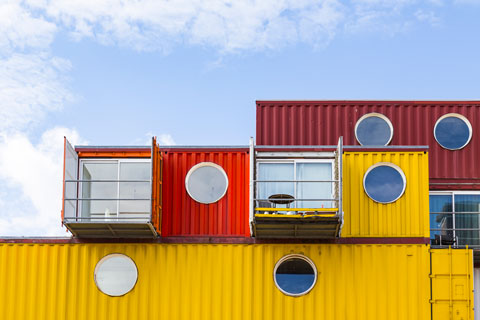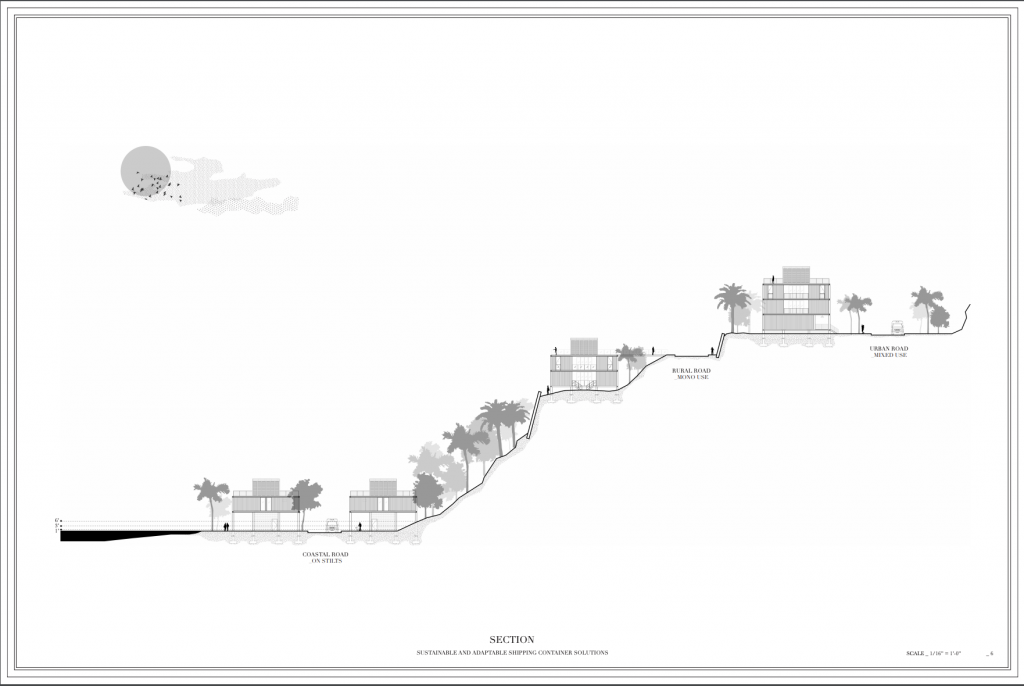
Professor Sonia Chao and her team are creating housing units for hurricane victims out of an unlikely source: shipping containers sustainably re-engineered into simple, safe homes.

It is estimated that at least 70,000 residents in the Bahamas were displaced by Hurricane Dorian and left homeless. Bahamians at Grand Bahama and Abaco Islands experienced extreme storm surge, and as seen in several viral videos, many people were left to take shelter in the framing of their roofs, watching their homes sit at the mercy of the ocean.
Seeing the destruction caused by Dorian was a sad moment for Chao, who recalled firsthand the wreckage left by Hurricane Andrew in 1992, which hit within hours of her move back to Miami.
“I was on one of the last international flights allowed into Miami,” Chao said. After the storm, Chao volunteered in the community to help residents rebuild. From here began her storied career in disaster relief and rebuilding efforts.
Since Hurricane Andrew, Chao, a research associate professor at the School of Architecture and director of the UM Center for Urban and Community Design, has been involved in providing relief and housing to natural disaster victims in several major catastrophic events including Katrina in 2005, the Haiti earthquake in 2010 and Harvey, Irma and Maria in 2017, receiving prestigious grants and fellowships along the way.
During the rebuilding process in 2017, Chao worked alongside her research assistant Alba Quintanilla, a UM graduate student in the School of Architecture, collecting data and running analysis on Houston, Key West and Puerto Rico to assess damage these communities had following major hurricanes. Chao got the idea to construct container homes, after talking to a HUD officer in Puerto Rico about some of the logistical issues they had faced including a lack of materials and difficulty in the deployment of mobile homes from FEMA. In light of this, Chao saw a real need for alternative emergency housing.
Chao decided to focus the efforts of her Emergency Shipping Container Solutions project to the Bahamas, bringing victims safe housing, not only to help them recover and rebuild after Dorian, but to get them ready for the possibility of future storms this hurricane season with homes engineered to withstand hurricane force winds and flooding.
“There are a lot of people who can’t get themselves prepared,” Chao said. “We want to be there for them.”
Her building kits will do just that.
The kits provide four to five pages of simple instructions and drawings, easy for an average to understand, outlining modifications to turn shipping containers into homes. These kits are “intended to help the layperson figure out how to build buildings that are robust and capable of sustaining the environmental pressures around them,” Chao said.
Landolf Rhode-Barbarigos, an assistant professor in the College of Engineering, has been working with Chao on the project since its inception. While Chao handled the functional design of the housing units, Rhode-Barbarigos focused on evaluating the structural capacity of these shipping containers and worked to ensure that modifications to adapt them to homes would not risk their structural integrity.
Rhodes-Barbarigos explained that by nature, the shipping containers, made of corrugated sheet panels with high-strength steel, are extremely durable and able to withstand hurricane and natural disaster conditions. Modifications when done properly, according to the kit’s instructions and with the consultation of licensed professionals, will not inhibit the units’ security.
The employment of shipping containers as a material and main structure of the homes serves as a sustainable building alternative, as many shipping containers remain empty or are scrapped for metal once cargo is delivered.
Chao and her team developed multiple variations of these container homes, able to accommodate varying topography and environmental conditions as well as different family needs. UM School of Architecture alumna Gabriella Feito, began working on the project with Chao when she was still a student as a research assistant, drawing out the housing solutions and conducting research on designs for tropical conditions.

Feito first became passionate about architectural design to address the climate crisis in a course she took with Chao at UM. She now works at Touzet Studio in Wynwood, a firm that is active in finding sustainable solutions. Since graduating in May, Feito has continued to do pro-bono work for Chao’s project.
“I can’t imagine what it feels like to be displaced and I believe that shipping containers are an excellent solution to fast housing,” Feito said. She hopes these new homes will give communities “a fighting chance” against hurricanes.
Beyond housing, Chao’s project could spur the development of micro-economies, providing jobs for local carpenters, plumbers or construction workers to finish up these structures.
Chao would like to see this deployed and produced for the Bahamas “as fast as possible.” She is looking for any partners, be it in the shipping, cruise, boating or construction industries, or non-profits willing to help.
“We are hoping to have partners help facilitate this and make this happen,” Chao said.
Residents in the Bahamas rebuilding with whatever available supplies they can scrap together “may result in even less structurally stable buildings,” Chao warned. As for the mobile homes that FEMA often deploys to areas that have been battered, these “unfortunately do not have structural integrity capable of addressing the wind forces of major hurricanes,” Chao said.
For Chao and her team, their efforts are all centered around helping as many people as they can recover and rebuild in a safer way that will make vulnerable coastal communities better prepared the next time a storm comes around.
“The more we can get out there, the more we can get closer to making this a reality and helping more families,” Chao said. “We see this as a real opportunity for us to create safe housing.”






